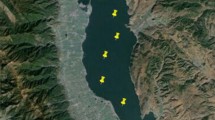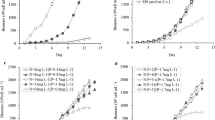Abstract
An experiment was carried out to evaluate the effects of phosphorus concentration (1, 4 and 10 mg l−1) and temperature (15 and 25°C) on chlorophyll a (chl a) contents and cell size/volume of green alga Scenedesmus obliquus and blue green alga Microcystis aeruginosa. Long-term field data from Lake Taihu, a large, shallow eutrophic lake between Jiangsu and Zhejiang Provinces, China, was also used to evaluate the effect of temperature on the model between chl a and total phosphorus (TP). The chl a content of both algae increased with an increase in phosphorus concentration and temperature. Temperatures showed a significantly different effect on chl a content of S. obliquus at a phosphorus concentration of 10 mg l−1, whereas there was no significant difference at the two lower phosphorus levels. For M. aeruginosa, temperatures presented significantly different effects on the chl a contents at three phosphorus concentrations. Chl a content of neither alga presented an interaction between the nutrient and the temperature. Long-term field data from Lake Taihu also indicated that the addition of temperature to the model increased predictability of chl a by TP. The length/diameter and volume of both algae were greater at the lower temperature and phosphorus concentration. Moderate negative correlations were observed between algal size, volume, and chl a content. Our results suggest that phosphorus concentration and temperature could change chl a contents and size in species-specific algal cells and that temperature should be considered when building the model of TP and chl a concentration.





Similar content being viewed by others
References
Ahlgren I, Frisk T, Kamp-Nielsen L (1988) Empirical and theoretical models of phosphorus loading, retention and concentration vs. lake trophic state. Hydrobiologia 170:285–303
Chen YW, Qin BQ, Teubner K, Dikulil MT (2003) Long-term dynamics of phytoplankton assemblages: Microcystis-domination in Lake Taihu, a large shallow lake in China. J Plankton Res 25:445–453
Dillon PJ, Rigler FH (1974) The phosphorus–chlorophyll relationship in Lakes. Limnol Oceanogr 19:767–773
Felip M, Catalan J (2000) The relationship between phytoplankton biovolume and chlorophyll in a deep oligotrophic lake: decoupling in their spatial and temporal maxima. J Plankton Res 22:91–106
Fujita Y, Ohki K, Murakami A (2001) Acclimation of phytosynthetic light energy conversion to the light environments. In: Rai LC, Gaur JP (eds) Algal adaptation to environmental stresses. Springer, Berlin
Havens KE, Nürnberg GK (2004) The phosphorus–chlorophyll relationship in lakes: potential influences of color and mixing regime. Lake Res Manag 20:188–196
Hill WR, Fanta SE, Roberts BJ (2009) Quantifying phosphorus and light effects in stream algae. Limnol Oceanogr 54:368–380
Hosper H, Meyer ML (1986) Control of phosphorus loading and flushing as restoration methods for Lake Veluwe, The Netherlands. Aquat Ecol 20:183–194
Huszar VLM, Caraco NF, Roland F, Cole J (2006) Nutrient–chlorophyll relationships in tropical-subtropical lakes: do temperate models fit? Biogeochemistry 79:239–250
Jezberová J, Komárková J (2007) Morphometry and growth of three Synechococcus-like picoplanktic cyanobacteria at different culture conditions. Hydrobiologia 578:17–27
Jin X, Tu Q (1990) (eds) The standard methods for observation and analysis in lake eutrophication. 2nd edn. Chinese Environmental Science Press, Beijing, pp138–272 (in Chinese)
Jones JR, Knowlton MF (2005) Chlorophyll response to nutrients and non-algal seston in Missouri Reservoirs and Oxbow lakes. Lake Res Manag 21:361–371
Kirillova T, Kirillov V, Lovtskaya O (2006) The dynamics of phytoplankton pigment characteristics of Lake Teletskoye. Hydrobiologia 568:45–50
Kruskopf M, Flynn KJ (2006) Chlorophyll content and fluorescence responses cannot be used to gauge reliably phytoplankton biomass, nutrient status or growth rate. New Phytol 169:525–536
Liu YQ, Xie P, Zhang DW, Wen ZR (2008) Seasonal dynamics of microcystins with associated biotic and abiotic parameters in two bays of Lake Taihu, the third largest freshwater lake in China. Bull Environ Contam Toxicol 80:24–29
Lu HC, Wang F, Chen YX (2003) Multianalysis between chlorophyll a and environmental factors in Qiandao Lake water. Chin J Appl Ecol 14:1347–1350
Malve O, Qian SS (2006) Estimating nutrients and chlorophyll a relationships in Finnish lakes. Environ Sci Technol 40:7848–7853
Masson S, Pinel-Alloul B, Smith VH (2000) Total phosphorus–chlorophyll a size fraction relationships in southern Québec lakes. Limnol Oceanogr 45:732–740
Mazumder A (1994) Phosphorus–chlorophyll relationships under contrasting herbivory and thermal stratification: predictions and patterns. Can J Fish Aquat Sci 51:390–400
McCauley E, Downing JA, Watson S (1989) Sigmoid relationship between nutrients and chlorophyll among lakes. Can J Fish Aquat Sci 46:1171–1175
Menéndez M, Herrera J, Comín FA (2002) Effect of nitrogen and phosphorus supply on growth, chlorophyll content and tissue compostion of the macroalga Chaetomorpha linum (O.F.Müll.) Kütz in a Mediterranean coastal lagon. Sci Mar 66:355–364
Morabito G, Oggioni A, Caravati E, Panzani P (2007) Seasonal morphological plasticity of phytoplankton in Lago Maggiore (N. Italy). Hydrobiolgia 578:47–57
Nichols KH, Dillon PJ (1978) An evaluation of the phosphorus–chlorophyll–phytoplankton relationships for lakes. Int Rev Gesamten Hydrobiol 62:141–154
Ou MM, Yang Y, Cai WM (2005) Physiological and biochemical changes in Microcystis aeruginosa Qutz. in phosphorus limitation. J Integr Plant Biol 47:692–702
Piirsoo K (2001) Phytoplankton of Estonian rivers in midsummer. Hydrobiologia 444:135–146
Rhee GY, Gotham IJ (1981) The effect of environmental factors on phytoplankton growth: temperature and the interactions of temperature with nutrient limitation. Limnol Oceanogr 26:635–648
Shei P, Lin WL, Wang SM, Liu JK (1993) Plankton and seston structure in a shallow, eutrophic subtropic Chinese lake. Arch Hydrobiol 129:199–220
Stoyneva MP, Descy JP, Vyverman W (2007) Green algae in Lake Tanganyika: is morphological variation a response to seasonal changes? Hydrobiologia 578:7–16
Van Nieuwenhuyse EE, Jones JR (1996) Phosphorus–chlorophyll relationship in temperate streams and its variation with stream catchment area. Can J Fish Aquat Sci 53:99–105
Wu J, Qian TM, Yu ZM (2001) The annual fluctuation of chlorophyll-a and the algal growth potential test in West Lake, Hangzhou. J Lake Sci 13:143–148 (in Chinese)
Xie P (2006) Biological mechanisms driving the seasonal changes in the internal loading of phosphorus in shallow lakes. Sci China Ser D 49(Suppl I):14–27
Xie P (2008) Historical development of cyanobacteria with bloom disaster in Lake Taihu. Science Press, Beijing (in Chinese)
Xie LQ, Xie P (2002) Long-term (1956–1999) dynamics of phosphorus in a shallow, subtropical Chinese lake with the possible effects of cyanobacterial blooms. Water Res 36:342–349
Yang LY (2004) Research on nutrient dynamics of bluegreen algae development and metabolism. In: Qin BQ, Hu WP, Chen WM (eds) Process and mechanism of water environment in Lake Taihu. Science Press, Beijing
Zhang ZS, Huang XF (1991) Methods on freshwater plankton. Science Press, Beijing
Acknowledgments
This work was supported by National Basic Research Program of China (973 program) (No. 2008CB418104), Foundation of NIGLAS (CXNIGLAS200813) and National Natural Science Foundation of China (No. 30900195). The authors gratefully acknowledge the comments from three anonymous reviewers.
Author information
Authors and Affiliations
Corresponding author
Rights and permissions
About this article
Cite this article
Chen, M., Li, J., Dai, X. et al. Effect of phosphorus and temperature on chlorophyll a contents and cell sizes of Scenedesmus obliquus and Microcystis aeruginosa . Limnology 12, 187–192 (2011). https://doi.org/10.1007/s10201-010-0336-y
Received:
Accepted:
Published:
Issue Date:
DOI: https://doi.org/10.1007/s10201-010-0336-y




